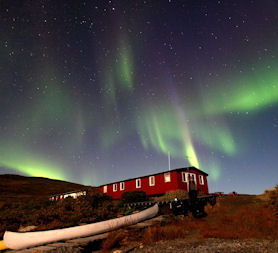Northern Lights visible in UK due to solar storms
The Aurora Borealis could be visible in the UK over the next few nights due to solar activity – but if you miss it, don’t despair, because it’s going to get better, an expert tells Channel 4 News.

The British Geological Survey (BGS) said there is a “good chance” of Northern Lights sighting over the next few nights amid the largest solar storms in four years.
Usually, it is only possible to see the displays at latitudes further north than the UK – places like Norway and Iceland have even made a tourist attraction out of viewing them.
But as a result of the unusual solar activity – which could also affect electrical power grids, communications systems and satellites – people in the UK, particularly in the north, could catch a glimpse of the dancing light patterns.
If you miss it tonight or conditions are cloudy, the message is: things are only going to get better. Dr Jim Wild
People in Northern Ireland have already been able to spot displays earlier this week.
The sightings depend on whether the solar activity peaks over night, and of course whether the skies are cloudy.
What causes the Northern Lights?
Since 13 February, three solar flares have erupted on the Sun, caused by the sudden release of magnetic energy stored in the star. These eruptions spew out clouds of charged plasma called coronal mass ejections, which then head out towards Earth.
The geomagnetic storms affect "space weather" and, when they reach Earth, can cause the Northern Lights displays.
The charged particles from the ejections are captured by the Earth's atmosphere, slowing them down and acting as a shield. They then collide with gas molecules in the atmosphere - and the energy released in these collisions is given off as light.
Read more: Tips on viewing the Northern Lights from the BGS or follow Lancaster University's AuroraWatch website or on Twitter @aurorawatchuk
Scientists now think that the displays may not be as dramatic as predicted, and Dr Alan Thomson, Head of Geomagnetism at the BGS, told Channel 4 News: “The further north you are the better your chances.
“In the Shetland Isles, you can see the Northern Lights up to once or twice a week – with the normal caveats, if the sky is clear and there’s not too much background light. But on the south coast, it’s maybe once a decade, if you’re lucky.
“This time, the magnetic storm caused by the solar storms does not seem to be having much impact so it’s probably only the north of Scotland.”
But if you miss it this time round, don’t despair.
More chances
Dr Thomson said that the increased activity on the Sun over the next few years could see more displays.
“Hopefully, we’ll be able to see one in the UK that we can all remember,” he said.
Dr Jim Wild, a Reader in Space Plasma Physics at Lancaster University, agreed with Dr Thomson, telling Channel 4 News the chances of seeing it in the UK are only going to improve in the next few years.
“The Sun has seasons, times when it is quiet and times when it is active,” he explained.
Over the next few years, hopefully we’ll be able to see a Northern Lights display in the UK that we can all remember. Dr Alan Thomson
“It takes around 11 years for one cycle – the next high activity time is 2013. These events are regular – it’s not some cataclysm we’re waiting for. But you do need the sun to be active to see the Aurora Borealis in the UK.
“The events we’ve seen in the Sun over the last week have been the largest in this cycle so far and the largest for a few years, but not the largest for 20 or 30 years by a long way. It’s like the first day of summer, when people say ‘ooh it’s warm’ – it might not be that war, but it feels it, because you’re just coming out of winter.
“So the message is: things are only going to get better. If you miss it tonight or conditions are cloudy, chances are it will get better.”
He also dismissed concerns over interference with satellites, communications and power grids when the storms are at their strongest over the next few years – saying that, while the networks do get affected, the operators are well prepared and only very major and rare events would make them re-think their coping mechanisms, with the help of scientists.
The current activity on the surface of the Sun has been captured by Nasa’s Solar Dynamics Observatory spacecraft – watch the video below.